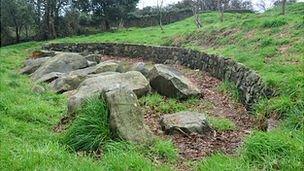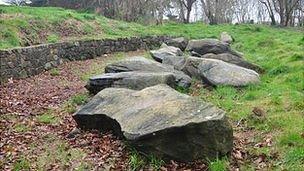Delancey Park Neolithic grave protection plan submitted
- Published

Dr De Jersey said the Neolithic gallery grave was the only example of its type found in Guernsey
A Neolithic grave in Guernsey could be half-buried in soil and grassed-over to preserve it.
Guernsey Museums and Art Galleries has asked for planning permission to conduct the work in Delancey Park and put up an information sign.
States Archaeologist Dr Philip De Jersey said covering part of the stones would hopefully protect them.
He said: "People have lit fires in between them so they crack... there's been graffiti... we want to stop that."
The grave was discovered and excavated in 1919, 1932 and in the summers from 2009-2011.
Dr De Jersey said the "gallery" grave was "the only known example in Guernsey".
He said other Neolithic graves in the island tended to be passage graves with a wider chamber.
Dr De Jersey said damage to the site was mainly believed to have been caused by people.
"We don't get a huge amount of frost here and there is what looks like some frost shattering on a couple of the pieces of granite so it [covering the site] might help stop that as well, but the main problems have been human," he said.
"The absolute last resort is fencing the site off... so I hope this will be a compromise, that people can still see it, but it will prevent damage."
Dr De Jersey said of the site currently: "It's collapsed, the capstones have long since vanished and what we have now are just the prop stones along each side, which have all fallen over in the past few thousand years.
"It's not a great deal to look at, it is a heap of stones and if you don't know anything about it you're none the wiser."
Archaeologist Dr George Nash, who led the most recent work, recommended the site should be enhanced and marked as one of educational value.
Dr De Jersey said: "There's not really anything more archaeological we can get out of it.

The Neolithic gallery grave was discovered and first excavated in 1919
"[The plan is to] effectively partially rebury the site, it won't be completely covered you'll still be able to see the top foot or so of the stones.
"The idea is that you can walk around it, you can still walk on the stones, but they'll be that much more protected.
"Part of it is protecting the site, but leaving it still visible and part of it is having better interpretation so people actually know what they're are looking at."
He said the plans were put forward with the support of the Admiral de Saumarez Trust, which is behind moves to upgrade and refresh the park and has offered to pay for materials.
Dr De Jersey said the plans involved "a layer of something inert like sand or gravel, which marks where previous excavations have got to, and then we'll put topsoil on top and fence it off to let the grass seed grow".
If the plans are approved work, which should only take a few days, is expected to start in March or April.
- Published9 February 2012
- Published3 January 2012
- Published25 May 2011